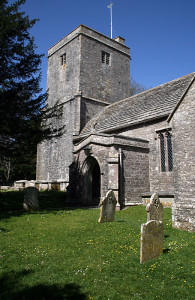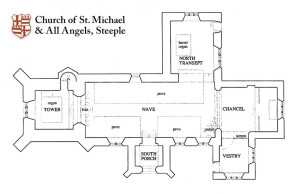
The Nave
The lower parts of the walls are 12th century (Norman), to which period belong also the north and south doorways, with their rounded archways, the former now blocked and the latter much scraped and reset by the Victorian restorers. In the north wall is a lancet window of the first half of the 13th century. Late in the medieval period (end of 14th century) the side walls were raised and larger windows inserted on the south side. Later still, perhaps in the 17th century, the plain two-light window high up at the west end of the south wall was pierced to light the gallery which formerly existed here. In the 19th century the easternmost window of the nave was renewed and the fine stained glass window depicting St. Michael and the Angels installed.
The nave has a plastered wagon roof of the West Country type, which was extensively repaired in 1954. At the intersection of its ribs are shields with the arms of Lawrence quartering those of Washington. On the west wall is the outline of the earlier roof.
The font is 12th century with plain round bowl and shaft. Both north and south walls of the nave are out of perpendicular; it is uncertain when this outward movement occurred and indeed it may always have been so.
The Tower
The tower is large compared with the rest of the church. It is buttressed at each of its four corners; at the north-east an unusual turret juts out, holding the staircase and rising a few feet above the parapet. The tower assumed its present form in the early 16th century, but there had been an older one, probably Norman, traces of which can be seen in the ringing chamber up the stairs. The masonry of the lower portion is roughly built of small stones, with a large one here and there, betokening the earlier work. The 16th century part above is more evenly coursed and pointed.
In the west is a large three-light window, only visible from the graveyard since the organ screens it from the nave. Its tracery is clumsy and it is probably not much more than a hundred years old.
The tower originally held three bells hung on a very fine medieval oak frame. One is an early 16th century bell, inscribed “Sancte Anne Ora Pro Nobis”. Inscriptions on the other two show they were cast by Anthony Bond in 1633 and 1634. During the extensive repairs in 1954 it was found that the oak frame was too badly infected by deathwatch beetle to be repaired. For over 30 years only the 1633 bell was rehung on one of the salvaged beams and the other two bells were displayed at the West end of the nave. In 1985, after a successful appeal for funds it was decided to rehang the Culverden bell dating from the early 16th Century and to store the third bell dated 1634 (which is cracked) in the ringing chamber.

The North Transept
This probably dates from the early 17th century (reign of James I). Set in the outside of its east wall is the finest of the carved stone shields bearing the arms of the Washington and Lawrence families, with the initials E.L. and the date 1616 (see illustration).
The timber ceiling was erected by Prebendary Nathaniel Bond (Rector 1852-89) when he rebuilt the chancel.
The South Transept
This, now used as a vestry, is said to have been built by William Bond of Blackmanston, who died in 1636 and was buried under the transept. Though there is no definite evidence to confirm it, it is likely that he intended this extension to the church as the Bond of Blackmanston family pew, even as the north vestry, built a few years earlier, was for the Lawrences of Creech.
The present cupboard in the vestry was originally the casing of the old barrel organ in Tyneham Church. The introduction of hynms in the 19th century no doubt created the requirement for some kind of automatic music, and the construction of barrel organs began. The one in Steeple was manufactured by the firm of J.W. Walker in 1858 and was in regular use till about 1890. It has three barrels, anyone of which can be brought into operation by rotating the iron frame on which they are mounted. When the barrel in use is turned the staples on the barrel open valves to the pipes, thus admitting air from the bellows and causing the pipes to speak. The barrel organ was restored in 1994 by the expert Mr John Gudgen.
When Tyneham Church was closed in 1943, its organ was brought to Steeple. This fine organ was given by Mr & Mrs Bond of Tyneham as a thank offering for the recovery of their son from a dangerous wound received at the siege of Ladysmith in South Africa in December 1899. The original pipes from the Steeple barrel organ were used to make up the Church Knowle Church organ. Steeple is now fortunate to have two working organs and both are used regularly.
The Chancel
The present chancel was rebuilt by Prebendary Nathaniel Bond (1852-1889) on the site of its predecessor. A touching memorial in its south wall dated 1641 sets forth the virtues and accomplishments of two members of the Chaldecott family of neighbouring Whiteway. In the floor are two stones commemorating members of the Bond family, 1674 and 1746; and one for Sarah Collens, 1675. It was Dennis Bond who gave his name to the now famous Bond Street in London’s Mayfair. Set in the north wall is a small medieval coffin-lid in Purbeck marble, carved with a cross in relief. It would either have been that of an infant or else a heart burial. Hutchins (History of Dorset, edition of 1860) records a Clavell tomb in the floor of the Church: Miss Woodward, in her Isle of Purbeck (1907), calls it almost illegible and today it cannot be deciphered. The shields on the corbels supporting the wall posts of the chancel roof bear the arms of the Bond family and their alliances.
The South Porch
This was likewise built in the 19th century by Prebendary Bond, who felt constrained to rebuild the Norman doorway as well. The porch acts as a buttress to the leaning south wall. On the interior of its east wall there is another stone shield with the arms of Washington impaling Lawrence, but undated; it was formerly in the south gable, over the entrance, and is less fine than the one outside the north transept.
Communion Plate
The chalice still in use for Holy Communion is a fine Elizabethan communion cup with a cover bearing the date 1574, and hallmark of a Dorchester silversmith. It is exactly similar to those of Church Knowle and Tyneham, which are all of the same shape but smaller than that of Wareham. It would appear that about this time there was a general order for the replacement of the old pre-Reformation chalices by communion cups of a different shape. Maybe it was thought that the chalices were not big enough when the Reformed Church insisted that the laity as well as the priest should receive the cup at communion; or perhaps the more extreme Protestant element desired to mark their doctrines by a change in the shape of the cup. A modern silver chalice, pattern bowl and jug were given in memory of members of the Braisby family from Blackmanston Farm within the parish. The altar and bishop’s chairs were made principally from oak trees felled in the great storm of 1991. They were designed by a parishioner and made by Mr Richard David, a talented local joiner.
Millennium Silver Cross and Candlesticks
These were especially commissioned and made for the church by Michael Lloyd to commemorate the 2000th year of Christ’s birth. They are on loan to but not kept in the church and are in use for celebrations such as at Easter and Christmas; they are beautiful examples of modern silver design and craftsmanship.
Registers
The registers of baptisms, marriages and burials start in 1548, and are complete from that date. The older volumes are deposited in the County Record Office, Dorchester.

